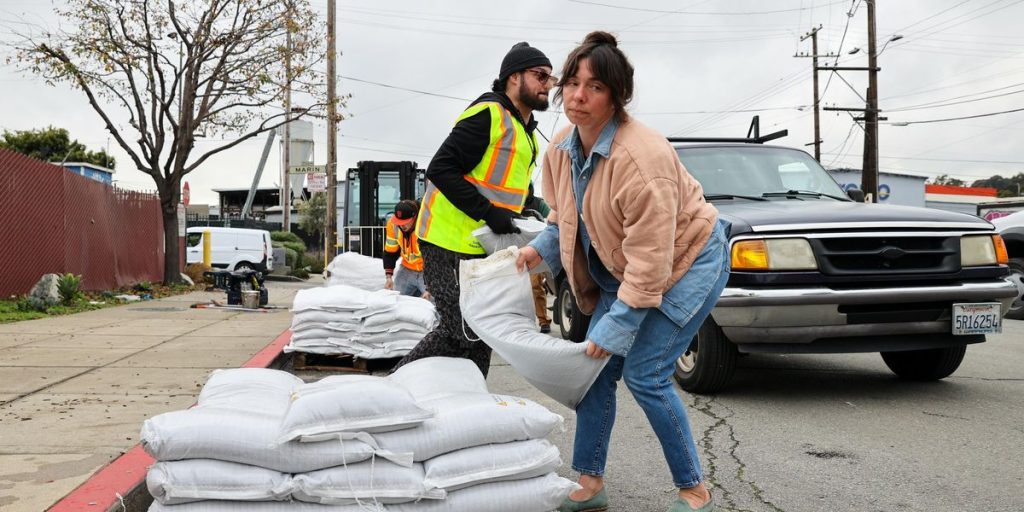
Hot on the heels of a major winter storm that inundated Northern California with torrential rains and deadly flooding, residents of the Golden State braced Wednesday for what’s expected to be an even more devastating storm—the latest climate chaos to wreak havoc in the U.S. West amid a worsening planetary emergency.
A super-potent combination of a
bomb cyclone and Pineapple Express atmospheric river has the nation’s most populous state on its highest level of emergency alert as the National Weather Service (NWS) said Wednesday that “a major storm and atmospheric river is poised to impact California today and Thursday with heavy to excessive rainfall, flooding with debris flows and landslides near recent burn scar areas, heavy mountain snow, and high winds.”
“To put it simply, this will likely be one of the most impactful systems on a widespread scale that this meteorologist has seen in a long while.”
“To put it simply, ” an NWS forecaster said, “this will likely be one of the most impactful systems on a widespread scale that this meteorologist has seen in a long while.”
“The impacts will include widespread flooding, roads washing out, hillside collapsing, trees down (potentially full groves), widespread power outages, immediate disruption to commerce, and the worst of all, likely loss of human life,” the forecaster continued. “This is truly a brutal system that we are looking at and needs to be taken seriously.”
Daniel Swain, a climate scientist at the University of California, Los Angeles (UCLA),
told the Los Angeles Times that “the main reason why this storm is going to have a larger impact than it would have had if it had happened two or three weeks ago is that it’s rained a lot in Northern California already recently, so everything’s really saturated.”
More than five inches of rain
inundated San Francisco on Saturday alone—the city’s second-wettest day ever logged in over 170 years of record-keeping.
“There’s already active river flooding with levee breaks in Sacramento County, so that’s the stage for something pretty intense coming in,” Swain added, referring to last week’s
deadly storm. “It’s this progression and sequencing that’s a big part of what’s going on.”
Experts have voiced concern that Wednesday’s storm is coming so quickly after last week’s atmospheric river.
As the
Los Angeles Times notes:
Compounding moisture isn’t the only cause for concern. Areas that have been burned by California’s wildfires are also susceptible to crashing torrents of mud, rocks, and other debris because of a lack of vegetation to help anchor the soil, said Chris Field, director of Stanford University’s Woods Institute for the Environment.
“In general, there’s a strong relationship between areas that are burned in wildfires and debris flow in the year following when there’s heavy rain,” he said. “And there’s every reason to think that we will see more debris flows when we have the series of storms we’re seeing now.”
In fact, one recent study out of UCLA found that in areas where more than a fifth of the forest had burned, stream flow increased by an average of 30% for six years after the fire, contributing to increased erosion, flooding, and other hazards.
Furthermore, years of drought in California have caused
record levels of arboreal mortality in forests as well as in urban areas, with dead trees posing a hazard to people, homes, and power lines during high winds.
While rainfall is desperately needed in a drought-ravaged state whose
10 largest reservoirs are anywhere from about one-third to three-quarters below capacity, experts say the current barrage of storms could be as much of a curse as a blessing.
“They’re two sides of the same coin: They can be extremely beneficial because they bring so much of California’s water supply to the state or they can also be drought busters,” Scripps Institute of Oceanography climate scientist Julie Kalansky
toldCNN. “But when the duration becomes too long, they become too strong, they come back-to-back, and the landscape doesn’t get an opportunity to absorb all the rain, it can lead to this flooding.”
UCLA’s Swain said that the winter deluge will benefit California in the short term, but that it would take far more than just one unusually wet year to end the drought.
“In a warming climate, the severity of droughts in places like the Southwest and California are being driven by increasing evaporative demand,” he told
CNN. “Essentially, the atmosphere is requiring more water as temperatures rise, so you’d actually need more precipitation than you used to have to balance that out—and we’re not necessarily seeing more precipitation than we used to.”

